The state of Alabama has a wide variety of turtles that call this southern state home. Wherever you go you may come across pond sliders, softshell turtles, tortoises, or even sea turtles.
There are over 30 different species that call this state their home. With so much territory to cover, let’s go ahead and dive straight into the different types of turtles found in Alabama.
Table of Contents
Pond Sliders in Alabama
1. Alabama Red-belly Turtle

- Experience level: Intermediate
- Family: Emydidae
- Scientific Name: Pseudemys Alabamensis
- Other Names: Alabama red-bellied turtle, Alabama red-belly cooter, red-belly, slider
- Average Adult Size: 10 – 14 inches
- Life Span: 40 – 60 years
- Average Price Range: Approximately $50 to $150
- Conservation Status: Endangered
The official state turtle and the state reptile of Alabama, this turtle is often found in canals, lakes, and other slow-moving bodies of water.
They have dark carapaces with lighter red or orange markings around the edges. Their plastron can be orange, red, or yellow and have darker markings. Their skin is olive to dark brown with yellow stripes.
Juveniles are more brightly colored as these markings fade as they age. Females are larger than males and can reach shell lengths up to 14 inches long.
The Alabama Red-belly turtle is mostly an herbivore and prefers waterways that have plenty of aquatic vegetation. They rarely leave the water except to bask or search for a nest to lay eggs.
2. Red Eared Slider

- Experience level: Beginner
- Family: Emydidae
- Scientific Name: Trachemys scripta elegans
- Common Name: Pond slider, Red-eared terrapin, Water slider
- Average Adult Size: 6 – 8 inches
- Life Span: 20 to 40 years
- Average Price Range: approximately $30 to $100
- Conservation Status: Least concern
These colorful, playful turtles are one of the most popular pet turtle species. Because of this popularity, they are often introduced to non-native waterways. Often the novelty wears off, or the turtle gets much larger than expected, and people unknowingly release them into the wild.
They don’t know that this can be detrimental to the turtle as well as native species, as red-eared sliders are survivors and will set up colonies in nearly any waterway.
These turtles have dark carapaces that darken as they age. Their skin is dark green to black with yellow stripes along the head, neck, and legs.
They have red patches behind their eyes that look like ears. Hence their name.
Red-eared sliders are omnivores and will feed on aquatic vegetation, insects, fish, carrion, mollusks, and whatever else they can catch and eat.
3. Yellow Belly Slider
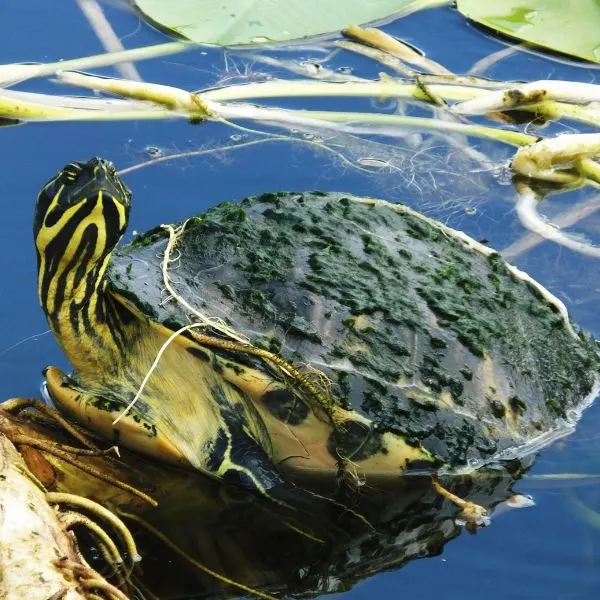
- Experience level: Beginner
- Family: Emydidae
- Scientific Name: Trachemys scripta scripta
- Other Names: Pond slider, Yellow slider
- Average Adult Size: 5 – 13 inches
- Life Span: 50 to 100 years
- Average Price Range: approximately $30 to $130
- Conservation Status: Least concern
Yellow belly sliders are close cousins to the Red eared slider. They have dark, olive green skin, but they have thicker yellow stripes. Sometimes they have yellow “S” shaped stripes on their faces or question mark shapes on their plastrons (lower part of the shell).
The carapace (upper shell) is dark and usually devoid of prominent markings.
Yellow belly sliders like to live in slow-moving creeks, rivers, streams, marshes, and ponds. When their habitat overlaps similar turtles such as the red-eared slider, these species may end up mating together.
This habit has caused some states like Florida to ban the sale of red-eared sliders in order to protect the less prolific yellow belly.
These turtles are carnivorous in their early years and begin to take on a more omnivorous diet as they age. They will eat insects, fish, plants, worms, mollusks, leeches, and other small aquatic creatures.
Painted Turtles in Alabama
4. Eastern Painted Turtle

- Experience level: Beginner
- Family: Emydidae
- Scientific Name: Chrysemys picta picta
- Common Name: Painted Turtle
- Average Adult Size: 4 – 10 inches
- Life Span: 30 – 50 years
- Average Price Range: Between $30 to $150
- Conservation Status: Least Concern
5. Southern Painted Turtle
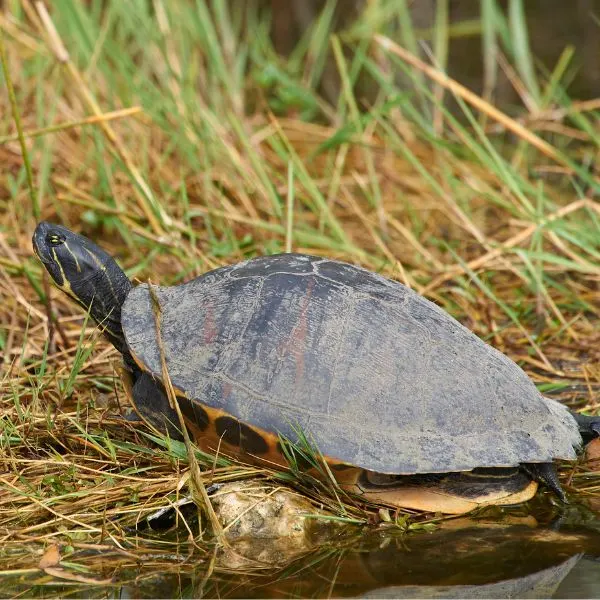
- Experience level: Beginner
- Family: Emydidae
- Scientific Name: Chrysemys picta dorsalis
- Other Names: Painted Turtle
- Average Adult Size: 4 – 6 inches
- Life Span: 20 – 25 years
- Average Price Range: $30 – $150
- Conservation Status: Least Concern
6. Midland Painted Turtle

- Experience Level: Beginner
- Family: Emydidae
- Scientific Name: Chrysemys picta marginata
- Other Names: N/A
- Adult Size: Between 4 and 10 inches
- Lifespan: Between 30 and 50 years
- Average price range: Between $30 and $150
- Conservation Status: Least Concern
Painted turtles found in Alabama look very similar with a few defining characteristics. Usually, only people who have extensive knowledge of the different species can confidently identify individual species.
The Southern painted turtle has a lighter colored stripe—usually red or orange but it can fade as they age—that runs the length of the carapace. Whereas the other species found in the state have plain, dark colored upper shells.
They all have yellow, cream, or whitish stripes along their heads and limbs.
All species of painted turtles prefer slow-moving rivers, lakes, and ponds. These turtles are omnivores, meaning they will eat insects, fish, aquatic animals, fruits, and other plants.
Cooter Turtles in Alabama
7. Eastern River Cooter

- Experience Level: Beginner to Intermediate
- Family: Emydidae
- Scientific Name: Pseudemys concinna concinna
- Other Names: River Cooter
- Adult Size: Between 8 and 12 inches
- Lifespan: Between 20 and 40 years
- Average Price Range: $20 to $50
- Conservation Status: Least Concern
River cooters are often found in slow to moderately fast moving rivers, but can sometimes be found in ponds, lakes, and drainage ditches.
They have flattened and flared carapaces with plenty of markings on the scutes. They have a blunt shaped heat with light colored, yellowish markings. The plastron on these turtles is usually yellow with little to no markings.
River cooters like to bask on logs or rocks above the water but will quickly dive for the water at the slightest threat.
They are omnivores but tend to eat more plant matter and algae. They will occasionally dine on crayfish and snails.
8. Florida Cooter
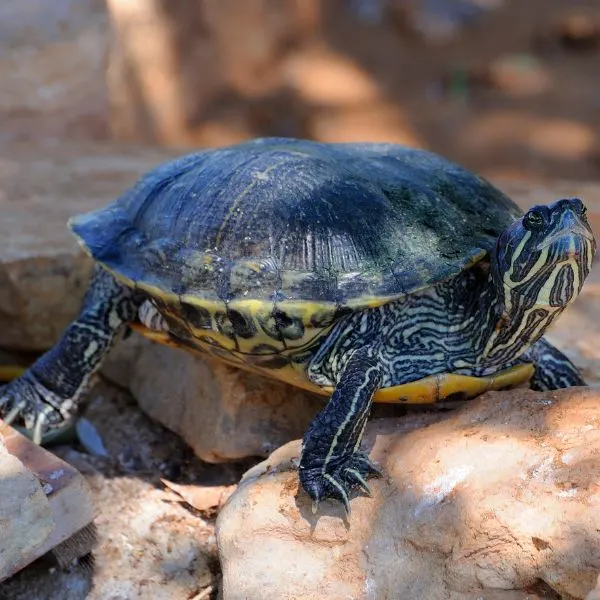
- Experience level: Beginner
- Family: Emydidae
- Scientific Name: Pseudemys floridana
- Other Names: Coastal plains cooter
- Average Adult Size: 9 – 13 inches
- Life Span: 20 – 40 years
- Average Price Range: Approximately $20 – $50
- Conservation Status: Least concern
The Florida cooter looks very similar to the Eastern river cooter, with the main distinguishing characteristics located on the carapace. Eastern river cooters tend to have stripe patterns on their shells, the Florida cooter shell patterns appear more net-like.
Another way to tell them apart is habitat. Florida cooters like water with sandy bottoms and plenty of vegetation such as wetlands, ponds, and marshes. River cooters like rivers, and streams with more water flow.
Female Florida cooters are more vegetarian whereas males like more meat in their diet.
Map Turtles in Alabama
9. Alabama Map Turtle

- Experience level: Beginner
- Family: Emydidae
- Scientific Name: Graptemys pulchra
- Other Names: Sawback, Alabama Map Turtle
- Average Adult Size: 5 – 11 inches
- Life Span: 15 – 20 years
- Average Price Range: Approximately $50-150
- Conservation Status: Near threatened
The Alabama Map Turtle is predominantly brown but has yellow, orange, or green markings that tend to fade with age. They also have a prominent keel across the top of their carapace. This gives their shells a pyramidal shape.
As with the markings, the keep tends to flatten some as they reach adulthood.
This species has marked sexual dimorphism as females are often twice as large as male Alabama Map turtles.
Alabama Map turtles inhabit slow-moving or stagnant bodies of water with lots of vegetation. They like bogs, swamps, ponds, and lakes.
Juvenile turtles tend to eat more vegetation such as duckweed and eat more aquatic invertebrates as they age. Females eat mostly snails because their strong jaws can crush the shells.
Smaller males eat more vegetation and softer insects and worms. Their heads and jaws have a hard time with the tough snail shells.
10. Barbour’s Map Turtle

- Experience level: Intermediate – expert
- Family: Emydidae
- Scientific Name: Graptemys pseudogeographica kohni
- Other Names: Barbour’s Sawback Turtle, Barbour Map Turtle
- Average Adult Size: 3 – 10 inches
- Life Span: 30 – 50 years
- Average Price Range: Approximately $150
- Conservation Status: Vulnerable
The Barbour Map Turtle has a very distinct carapace. They have large spines along the ridge with dark colored, to black tips. Their skin is brown to black and has light yellow or green striped markings.
Males only grow to about 5 inches in length whereas females can get more than double that size.
Barbour’s Map turtles can be found in stagnant, or slow-moving waters with plenty of vegetation. They like streams, lakes, ponds, and other areas with very little current.
These turtles are omnivorous and will eat nearly anything they can find. This includes insects, crayfish, and vegetation.
11. Black-Knobbed Map Turtle

- Experience level: Beginner
- Family: Emydidae
- Scientific Name: Graptemys Nigrinoda spp.
- Other Names: Black-knobbed Sawback, Sawback turtle
- Average Adult Size: 5 – 10 inches
- Life Span: 20 – 30 years
- Average Price Range: $150 to $250
- Conservation Status: Near threatened
The most prominent feature of these turtles is the raised, black knobs on the top ridge of their shells. The rest of their carapace is dark green with map-like markings. Their skin is black and has yellow or white markings.
The plastron is typically yellow with a black branching pattern.
Males are significantly smaller than females. Male black-knobbed map turtles max out around 5 or 6 inches in length, whereas females can get 10 to 12 inches long.
Like other map turtles, this species prefers slow-moving or stagnant waters and areas with soft bottoms and lots of vegetation.
Black knobbed map turtles are omnivorous, meaning they eat insects, meat, and vegetation.
12. Northern Map Turtle
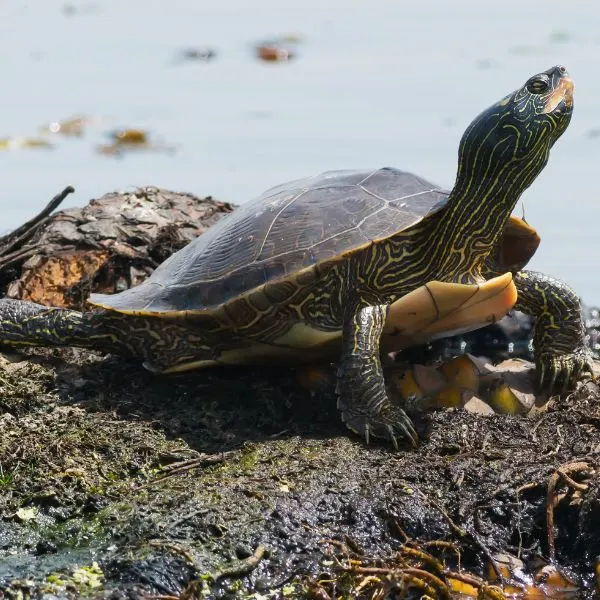
- Experience Level: Beginner
- Family: Emydidae
- Scientific Name: Graptemys geographica
- Other Name: Common map turtle
- Adult Size: Between 4 and 10 ½ inches
- Lifespan: 15 to 20 years
- Average price range: Between $20 and $60
- Conservation Status: Least concern
The patterns and markings on the Northern Map Turtle’s shell resemble the appearance of a topographical map. They also have a ridged keel along the top of the carapace. Both of these types of markings fade as the turtle ages.
They have dark skin with thick, lighter colored markings all over. These too darken as the turtle gets older.
The Northern Map turtle likes areas such as rivers, streams, and other areas with soft bottoms and a lot of vegetation. They also look for areas that have plenty of basking spots as they like to spend plenty of time in the sun.
Males and females are omnivorous, but females, being much larger, are able to handle larger prey such as clams and crayfish. They have to swallow their food in the water so they are never observed eating on shore.
13. Ouachita Map Turtle

- Experience Level: Beginner
- Family: Emydidae
- Scientific Name: Graptemys Ouachitensis
- Other Names: Southern Map turtle
- Adult Size: 3.5 to 10 inches (9 to 25.5 cm)
- Lifespan: 15 to 20 years
- Average Price Range: $40 to $100
- Conservation Status: least concern
The Ouachita Map turtles are very similar to Northern Map turtles. They have similar habitats and feeding habits, they look similar and grow to about the same size as one another.
The main way to tell these two species of turtles is to look closely at the markings behind their eyes. The Ouachita Map turtle has a larger, rectangular marking behind its eyes, and Northern Map turtles have a crescent shaped marking.
14. Escambia Map Turtle
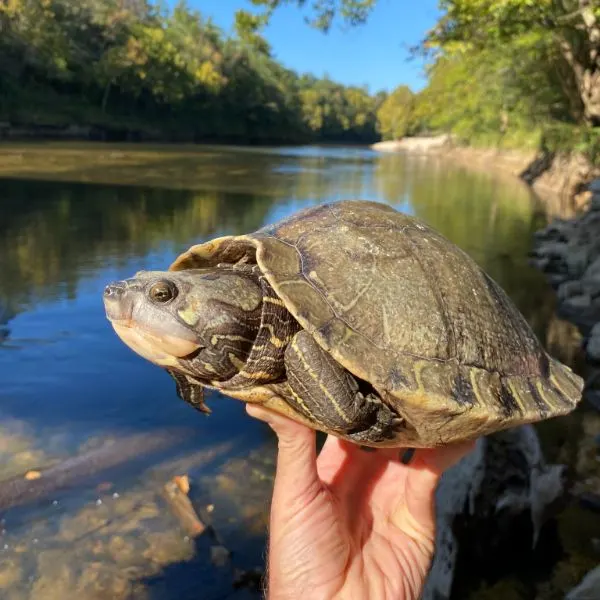
- Experience level: Intermediate
- Family: Emydidae
- Scientific Name: Graptemys ernsti
- Other Names: N/A
- Average Adult Size: 5 – 11 inches
- Life Span: 20 – 30 years
- Average Price Range: Approximately $100 to $300
- Conservation Status: Near Threatened
The male and female Escambia Map Turtle differ greatly in appearance. Females grow larger than males and have disproportionate heads with thick jaws in comparison to their bodies.
Males only grow about half the size of females, and they keep a smaller, juvenile shaped head. The male Escambia Map turtle also tends to keep some of the prominent keel, but the ridges on female turtles will all but disappear.
Escambia Map turtles have similar markings on their skin as other map turtle species, but they have large, light colored clumps on the tops of their heads.
The Escambia Map turtle is almost exclusively carnivorous. Females feed mostly on bi-valve clams, as they have the big heads and strong jaws to crush the shells. Males eat mostly insects and larvae.
Mud Turtles in Alabama
15. Striped Mud Turtle

- Experience level: Intermediate
- Family: Kinosternidae
- Scientific Name: Kinosternon baurii
- Common Name: Mud Turtle, Striped Mud Turtle
- Average Adult Size: 3 – 4 inches
- Life Span: 30 – 50 years
- Average Price Range: Approximately $20 – $60
- Conservation Status: Least Concern
Striped Mud Turtles have only recently been discovered in Alabama. There is not a lot of information on their status in the state yet, but they are thought to be transplants.
These tiny turtles only reach about 4 inches in length. They have a small, brown carapace that has three lighter stripes running from front to back. They have a pair of yellow stripes on each side of their heads as well.
They are often confused with the common musk turtle, but Striped Mud turtles don’t have the foul smelling musk glands that the stinkpots have.
The Striped Mud turtle rarely leaves the water unless they are searching for food or nesting sites. On land, they often hide under damp leaves, and burrow in the mud. Often these turtles are found sifting through cow dung searching for insects to eat.
They prefer slow moving or still water with soft bottoms and a lot of vegetation. They are omnivorous but prefer insects and other small aquatic animals.
16. Eastern Mud Turtle

- Experience level: Intermediate
- Family: Kinosternidae
- Scientific Name: Kinosternon subrubrum
- Common Name: Mud Turtle, Eastern Mud Turtle
- Average Adult Size: 5 – 7 inches
- Life Span: 30 – 50 years
- Average Price Range: approximately $65 – $100
- Conservation Status: least concern
The Eastern Mud turtle is a very plain looking turtle. Their shells lack distinguishing patterns and are solid colored. They can be dark yellow to black.
They do have white to yellow stripes on their heads, though their limbs are solid colored and usually very dark.
Eastern Mud turtles like to live in lakes, marshes, and swamps with soft, muddy bottoms and often walk instead of swim.
Mud turtles are omnivorous, eating fish, snails, insects, fruits (if they fall into the water), vegetation, and algae.
Musk Turtles in Alabama
17. Loggerhead Musk Turtle

- Experience level: Beginner
- Family: Kinosternidae
- Scientific Name: Sternotherus minor
- Common Name: Stripe head, loggerhead turtle
- Average Adult Size: 2 – 4 inches
- Life Span: 20 – 40 years
- Average Price Range: $50 – $200
- Conservation Status: Least Concern
The Loggerhead Musk Turtle has a large bulbous head, but it’s one of the smallest turtles found in the United States. They only grow to about 3 to 4 inches long.
They have large, prominent scutes along the top of their shells that usually have ridges. These become less pronounced as they age.
The carapace is light brown in color and often has a small black streak. The plastron is light brown or yellow and has no markings. The head and limbs are black or dark brown with light brown stripes and streaks.
These tiny turtles prefer slow-moving or stagnant waters as they aren’t great swimmers. The Loggerhead musk turtle is mainly carnivorous. Its diet consists of snails, insects, tadpoles, and fish.
18. Flattened Musk Turtle
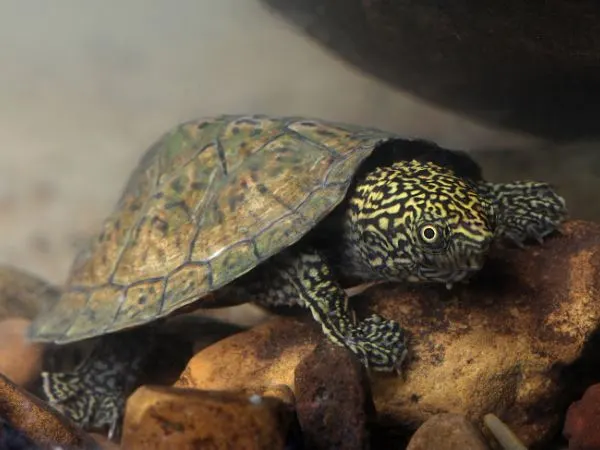
- Experience level: Beginner
- Family: Kinosternidae
- Scientific Name: Sternotherus depressus
- Common Name: Musk Turtle
- Average Adult Size: 4 – 5 inches
- Life Span: 30 – 50 years
- Average Price Range: Approximately $60 – $100
- Conservation Status: High Concern
The Flattened Musk turtle has just that, a flattened looking shell with slightly flared out edges. Its upper shell is dark brown with small black spots, while the bottom is usually light brown.
The skin looks almost identical to the Loggerhead musk turtle. It has black skin with lighter brown stripes throughout.
This turtle is a bottom dweller that rarely breaks the surface of the water. They are rather secretive and tend to be nocturnal or crepuscular. Meaning they are more active during dusk and dawn, especially in the long hot summer months.
Once they were found throughout Alabama, because of habitat loss these turtles are not almost exclusively found along the Black Warrior River Basin.
The Flattened Musk turtle is a carnivorous turtle that eats mostly clams, mollusks, fish, and carrion.
19. Razor-backed Musk Turtle

- Experience level: Beginner
- Family: Kinosternidae
- Scientific Name: Sternotherus Carinatus
- Common Name: Mississippi Musk Turtle
- Average Adult Size: 5 – 6 inches
- Life Span: 40 – 50 years
- Average Price Range: approximately $60 – $160
- Conservation Status: least concern
The Razor-backed Musk Turtle has a keel on its shell that gives this turtle a pyramidal shape. The shell is often grey to dark green or black. The scutes have darker lines complimenting the lighter colors. Skin color also depends on the individual.
An aquatic turtle, the Razor-Backed Musk turtle often leaves the water to spend plenty of time basking in the warm sun.
All musk turtles have glands on their back legs that can produce an oily, powerful smelling substance that protects them from predators. Most of these turtles are very small so they need something more than a shell to protect them.
These turtles, like most other musk turtles, are carnivorous.
Snapping Turtles in Alabama
20. Common Snapping Turtle
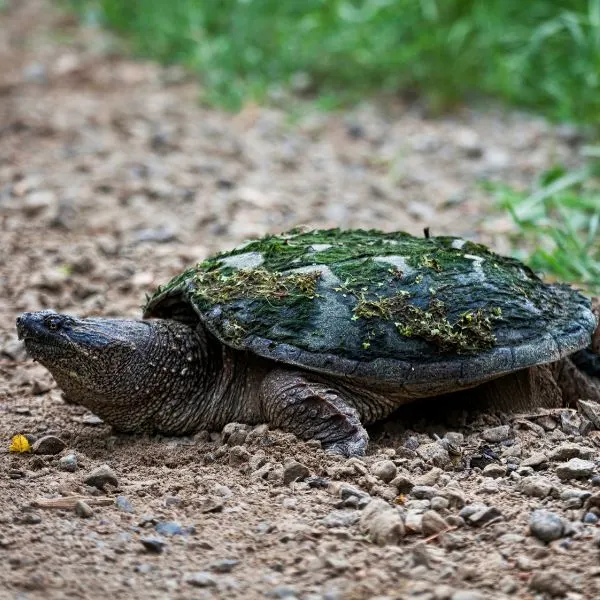
- Experience level: Intermediate to Expert
- Family: Chelydrida
- Scientific Name: Chelydra Serpentina
- Common Name: Common Snapping Turtle, Snapper, Eastern Snapping Turtle
- Average Adult Size: 8 to 20 inches
- Life Span: 30 – 50 years
- Average Price Range: Approximately $40 to $120
- Conservation Status: Least concern
The Common snapping turtle is shy by nature but can have a nasty disposition when they are out of the water. They have a sharp beaks that can give a nasty bite to unwary people.
They are ambush predators that like to sit at the bottom of lakes, ponds, and other slow moving bodies of water and wait for prey to swim by. When a fish, frog, smaller turtle, or anything it can fit into its jaws swims by, the turtle snaps it up.
Snapping turtles are large, thick shelled turtles with long, serpentine necks, and thick limbs. They also have very long tails compared to other species of turtles.
Common Snapping turtles are usually dark green to black in color, and will frequently be covered in algae as they rarely leave the water. They will even bask without leaving the safety of the water.
Females will come onto dry land to find a suitable nesting spot, and then inhabit that area until they leave to find another nesting area.
Though they consume mostly meat, snapping turtles are omnivorous and will sometimes consume vegetation and algae.
21. Alligator Snapping Turtle

- Experience level: Expert
- Family: Chelydrida
- Scientific Name: Macrochelys temminckii
- Common Name: Loggerhead Snapper
- Average Adult Size: 13-30 inches
- Life Span: 30 – 50 years
- Average Price Range: Approximately $50 to $300
- Conservation Status: Least concern
Alligator Snapping Turtles are the largest and heaviest of freshwater turtles. They average about 150 to 175 pounds, but the largest was rumored to be nearly 400 pounds. It was never officially recorded.
Alligator snappers are very intimidating looking. Their limbs are stout, they have huge heads with very powerful jaws able to inflict up to 1,000 pounds of bite force, and have pointed scutes across their thick shell.
Even though these turtles look ferocious, they don’t seek to harm humans. The reason people get bitten is because they try to handle these beasts. When confronted, the alligator snapping turtle will hiss to warn, and then bite if they are still bothered.
They are ambush predators. Preferring to lay nearly submerged at the bottom of lakes, ponds, and swamps with their mouths open. They have a fleshy appendage on their tongue that looks like a wriggling worm.
When a fish or anything else comes to investigate, the turtle snaps down with such speed that nothing escapes. They are mainly carnivores, but they have been observed eating vegetation on occasion.
22. Eastern Chicken Turtle

- Experience level: Beginner
- Family: Emydidae
- Scientific Name: Deirochelys reticularia
- Other Names: N/A
- Average Adult Size: 6 – 9 inches
- Life Span: 13 – 20 years
- Average Price Range: $150 – $300
- Conservation Status: Threatened
The chicken turtle is so named because it used to be harvested for meat, and was said to taste like chicken. Turtle meat is still consumed in many countries, but it has since declined in popularity in the United States.
Chicken turtles have egg shaped, domed shells that are typically dark green with some lighter to yellow net-like patterns. They have a very long neck that’s striped with yellow streaks. The plastron is solid yellow.
They are somewhat terrestrial turtles and will brumate in burrows in forested areas. They also have a winter egg laying habit. They tend to lay eggs in February and March, and these eggs may take a year or longer before they hatch.
Another interesting trait these turtles have is they tend to live longer in the wild than in captivity. Usually, animals in the wild perish sooner because of predation, lack of food and resources, and medical care.
In the wild, these turtles can live for 20 to 24 years, but in captivity, they may only live between 13 to 18 years.
Chicken turtles are mostly carnivorous. They especially eat crayfish, tadpoles, insects, and fish.
Softshell Turtles in Alabama
23. Florida Softshell
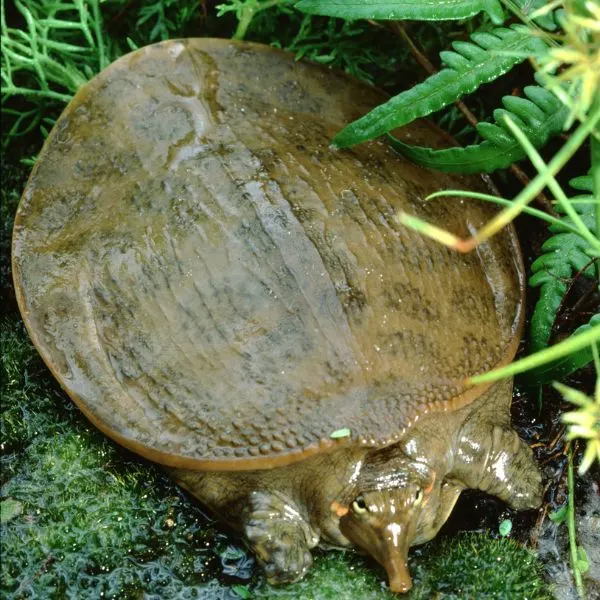
- Experience level: Intermediate
- Family: Trionychidae
- Scientific Name: Apalone ferox
- Other Names: Softshell turtle
- Average Adult Size: 6 – 24 inches
- Life Span: 20 – 50 years
- Average Price Range: approximately $60 – 260
- Conservation Status: Least concern
24. Eastern Spiny Softshell
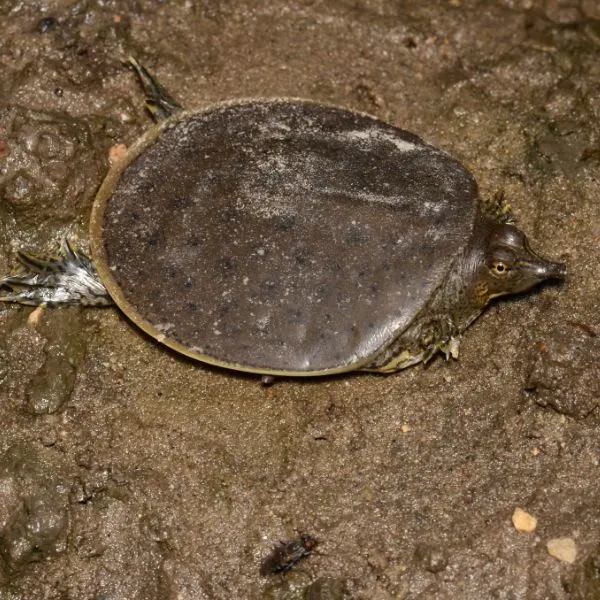
- Experience Level: Intermediate to Expert
- Family: Trionychidae
- Scientific Name: Apalone spinifera spinifera
- Other Names: N/A
- Adult Size: 5 to 9 ½ inches for males, 10 to 20 inches for females
- Lifespan: Between 20 and 50 years
- Average Price Range: Between $20 and $120
- Conservation Status: Least Concern
25. Gulf Coast Smooth Softshell
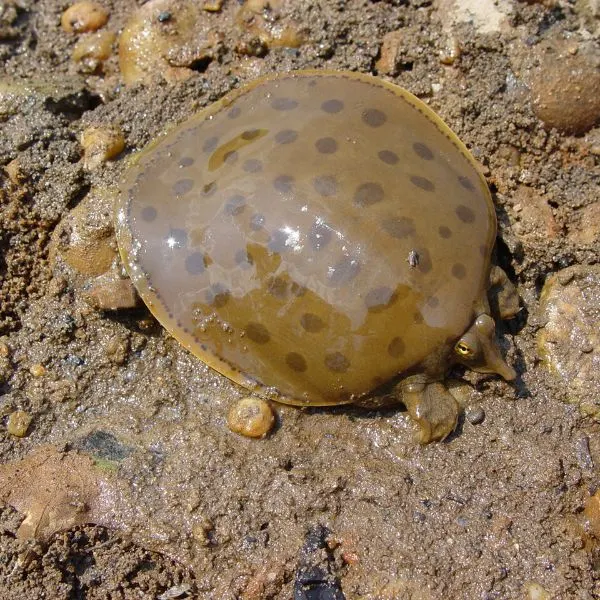
- Experience level: Intermediate
- Family: Trionychidae
- Scientific Name: Apalone mutica calvata
- Other Names: N/A
- Average Adult Size: 5 – 15 inches
- Life Span: 25 – 50 years
- Average Price Range: $60 -$200
- Conservation Status: Least concern
26. Gulf Coast Spiny Softshell
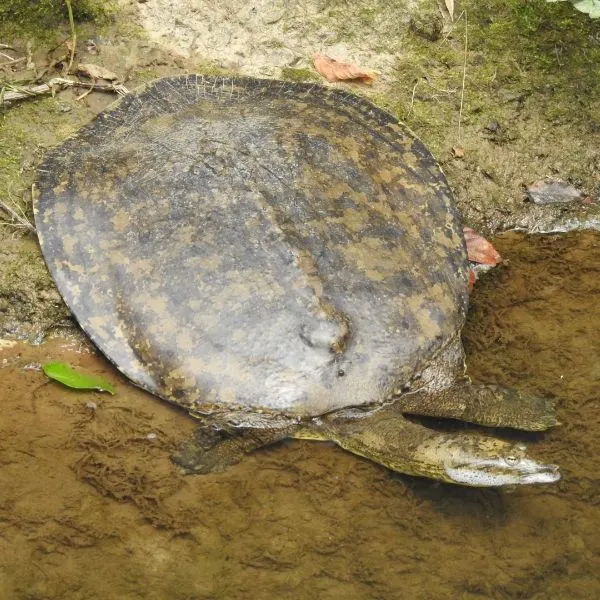
- Experience level: Intermediate
- Family: Trionychidae
- Scientific Name: Apalone spinifera aspera
- Other Names: N/A
- Average Adult Size: 5 – 19 inches
- Life Span: 25 – 50 years
- Average Price Range: approximately $60 – $200
- Conservation Status: Least concern
27. Midland Smooth Softshell

- Experience level: Intermediate
- Family: Trionychidae
- Scientific Name: Apalone Mutica Mutica
- Other Names: N/A
- Average Adult Size: 5 – 14 inches
- Life Span: 10 – 20 years
- Average Price Range: $50 – $150
- Conservation Status: Least Concern
All the Softshell turtle species in Alabama have very similar habits and look very similar to each other aside from having a few different colorations and some are spiny, while others are smooth.
Spiny softshell turtles have fleshy tubercles across the front ridge of their shells and partially across the back. Their shells feel like rubbery or leathery sandpaper. Smooth softshell turtles don’t have tubercles, but their shells are still soft and flattened.
These turtles are amazingly fast on land and accomplished swimmers. They can be aggressive out of the water because they know their floppy shells offer very little protection against hungry predators.
Softshell turtles have long necks, and long snouts to help them reach the surface of the water to breathe without going too far. Most times they will lay at the bottom of the water and stretch their necks up without moving their body.
Softshell turtles prefer waters with soft, muddy, or sandy bottoms so they can bury themselves in them and ambush their prey.
These aquatic turtles will leave the water to bask and lay eggs, but they will quickly dive back in at the first hint of trouble.
There is distinct sexual dimorphism between males and females. Males are typically about half the size of females in softshell turtle species. Males do have a longer tails than the ladies though.
All of the softshell species found in Alabama are mostly carnivorous. They will eat fish, aquatic invertebrates, insects, and some larger turtles that have been known to eat ducklings, and small birds, but this is rare. They will eat vegetation but prefer meat to greens.
Terrapins in Alabama
28. Mississippi Diamondback Terrapin

- Experience level: Intermediate to Expert
- Family: Emydidae
- Scientific Name: Malaclemys terrapin pileata
- Other Names: Mississippi Diamondback Terrapin, Diamondback Terrapin
- Average Adult Size: 5.5 – 11 inches
- Life Span: 25 – 40 years
- Average Price Range: $300 to $1,000 It’s illegal to own Diamondback terrapins in some states, while you need a special permit to own them in other states, including Alabama.
- Conservation Status: Endangered
Mississippi Diamondback Terrapins are incredibly endangered and you’ll have to check local reptile owning laws to see if you can own one of these turtles. In Florida for instance, it’s illegal to own these turtles at all.
Terrapin basically means turtle, but it’s an old-world term that has stuck to the diamondback.
These little turtles have brown or black carapaces with a patterned, yellow plastron. Their skin is usually gray or white with black spots all over.
The Mississippi Diamondback terrapin is a turtle that inhabits brackish water along the Gulf Coast. They inhabit salt marshes, estuaries, and tidal creeks along offshore beaches and islands.
They often swim among marsh grasses looking for snails, clams, crabs, fish, and carrion. These little turtles often meet their demise in crab traps. They go in looking for a meal, and then can’t get out and drown. This is one of the reasons they are so endangered.
They also have many predators, especially small juveniles and hatchlings. Raccoons, large fish, gulls, and wading birds feed on the Mississippi Diamondback Terrapins.
The Mississippi Diamondback Terrapin can tolerate some freshwater, but they need the somewhat salty brackish water for survival.
Box Turtles in Alabama
29. Eastern Box Turtle

- Experience Level: Beginner
- Family: Emydidae
- Scientific Name: Terrapene carolina carolina
- Other Names: Land Turtle
- Adult Size: 4 to 7 inches
- Lifespan: 50 to 100 years
- Average Price Range: $260 – $360
- Conservation Status: Endangered
The Eastern Box Turtle has a high domed shell that has hinges at the front and back. This allows the turtle to completely pull its head and limbs inside the shell.
Box turtles have a dark colored shell with yellow, orange, or sometimes red markings on each scute. Their skin is dark brown, to black with yellow spots and markings. Males typically have red eyes while females have brownish-yellow eyes.
Eastern Box turtles are mostly terrestrial and spend most of their time on the forest floor or in cool, damp burrows. When it really gets hot, they may migrate closer to water sources.
These turtles are some of the slowest reproducing turtle species in the world. They reach sexual maturity in six to seven years but only lay one clutch of 2 to 8 eggs per year. Many females will not lay eggs every year, so they reproduce very slowly.
Eastern Box turtles are omnivorous and will eat fruits, plants, carrion, worms, and insects.
Tortoises In Alabama
30. Gopher Tortoise

- Experience level: N/A
- Family: Testudinidae
- Scientific Name: Gopherus polyphemus
- Other Names: Gopher, gopher turtle, hoover chicken
- Average Adult Size: 10 – 15 inches
- Life Span: 40 – 60 years
- Average Price Range: It is illegal to own a Gopher Tortoise as a pet
- Conservation Status: Vulnerable
Gopher Tortoises are endangered and as such have been listed as a protected species. It is illegal to domesticate or own a Gopher Tortoise as a pet.
These tortoises live in sandy, soft soiled areas with open canopies. Here they can easily dig the long burrows then need to cool off and brumate during winter. They can dig burrows as long as 30 feet, and may have multiple entrances.
Gopher Tortoises have large, domed, dark gray, or brown carapaces with yellowish plastrons. Their skin can be dark gray, tan, or brown, and their front legs have thick, hardened scales used for excavating their burrows.
The Gopher Tortoise is mainly an herbivore. It feeds on grasses such as wiregrass, legumes, and broadleaf grasses. They will also eat flowers, herbs, and fruits.
Sea Turtles Found On Alabama’s Coast
31. Atlantic Leatherback Sea Turtle
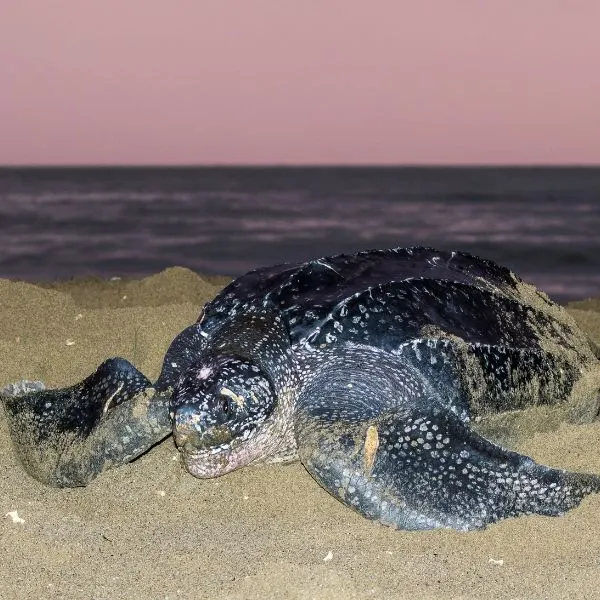
- Experience level: N/A, Illegal to own any sea turtle
- Family: Dermochelyidae
- Scientific Name: Dermochelys coriacea
- Other Names: Atlantic Leatherback, Leatherback
- Average Adult Size: 4 – 8 ft
- Life Span: 30 – 50 years
- Average Price Range: N/A
- Conservation Status: Endangered
The Atlantic Leatherback is the largest of all sea turtles, reaching lengths up to 8 feet long, and weighing nearly 2,000 pounds. They may visit the coast of Alabama, but they don’t nest here.
They nest in a few places along the coast of Florida and other tropical waters.
Leatherback Sea turtles don’t have a typical shell. Instead, their backs are composed of small bones that are covered in a leathery, black skin, that has a multitude of white spots. They are also the only sea turtle without scales, instead, they have smooth skin covering their bodies.
Their diet is mostly jellyfish, but they will also eat squid, some crustaceans, and sea squirts.
32. Green Sea Turtle

- Experience level: N/A, Illegal to own any sea turtle
- Family: Cheloniidae
- Scientific Name: Chelonia mydas
- Other Names: Green Sea Turtle
- Average Adult Size: 3 – 4 feet
- Life Span: 50 – 70 years
- Average Price Range: N/A
- Conservation Status: Endangered
Green Sea Turtles are the largest hard shell sea turtles. They can grow to lengths of 4 feet and weigh up to 500 pounds.
They are named Green Sea turtles not because they are green. The heart-shaped shells are usually a blend of colors, and their skin is white or cream colored with green scales.
These turtles get their name because of the algae they eat, and how it turns their flesh green. Green sea turtles used to be harvested for their meat, but are now a protected species.
They lay up to seven clutches of eggs during the nesting season, but then they take 2 to 4 years off from laying eggs.
Green Sea turtles feed exclusively on algae and plant matter as adults. It’s thought that babies are omnivorous, and eat whatever is available to them.
33. Kemp’s Ridley Sea Turtle

- Experience level: N/A, Illegal to own any sea turtle
- Family: Cheloniidae
- Scientific Name: Lepidochelys kempii
- Other Names: Atlantic Ridley, Tortuga Lora (Mexico)
- Average Adult Size: 24 – 27 inches
- Life Span: 30 years
- Average Price Range: N/A
- Conservation Status: Critically endangered
Kemp Ridley Sea Turtles are the most endangered sea turtles, and also the smallest. They rarely reach lengths over 2 feet long, and only weigh around 80 pounds.
These are the only sea turtles that nest during the day. All other species come ashore during the dark of night in an effort to protect the nests from predators.
The Kemp Ridley Sea turtle feeds mainly on crabs, shrimp, clams, sea stars, jellyfish, snails, and fish.
34. Loggerhead Sea Turtle

- Experience Level: N/A, Illegal to own any sea turtle
- Family: Cheloniidae
- Scientific Name: Caretta Caretta
- Other Names: Loggerhead
- Adult Size: 2.5 – 3.5 feet
- Lifespan: 70 – 80 years
- Average Price Range: N/A
- Conservation Status: Endangered
The Loggerhead Sea turtle is so named for its large head and massive jaw muscles. It uses these oversized jaw muscles to crack the shells of its prey. Loggerhead turtles eat whelks, conch, horseshoe crabs, and other hard shelled creatures.
Though they are the most widely distributed and most abundant sea turtles in the world, they are still endangered. Loggerhead turtles are found in temperate waters across the Atlantic, Indian, and Pacific Oceans as well as the Mediterranean Sea.
Loggerheads frequently nest along Alabama’s coastal waters. It’s the only sea turtle that regularly nests here.
Wrapping Up
Alabama definitely has a large and very diverse assortment of turtles. The state probably has the most species of turtles of any state in the entire U.S. The varying landscape and multitude of lakes, swamps, wetlands, and rivers allow such a wide array of reptiles.
We hope this article has been informative, and entertaining, and if you learned something, then it’s an added bonus. We love to hear from our readers, so if you have seen any of these turtles or have experiences of your own, drop us a line!
Other nearby states
